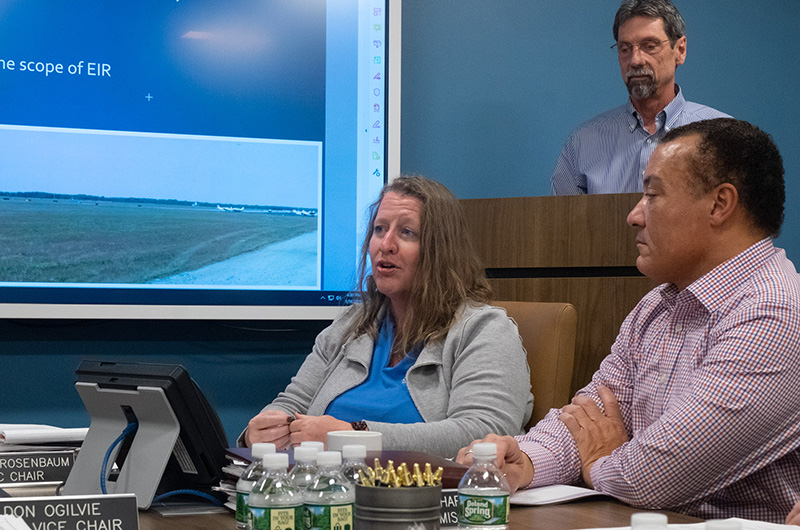Airport commissioners this week sought to downplay plans for a major expansion of the airport, saying an upcoming environmental hearing is just the first step in a lengthy review and approval process.
“We’re not scheming to turn the airport into the next LAX,” said Robert Rosenbaum, chairman of the airport commission, at a meeting Wednesday.
Before any plan could be implemented, the airport would need to get state and local permits, perform engineering studies and secure funding, he said.
“If, and only if, all of those steps have been approved can we move forward with the project,” he said.
A series of nine projects ranging from repaving and reconstructing runways to doubling the size of the airport terminal is outlined in a document filed by Airport Director Ann Richart with the Massachusetts Environmental Policy Act (MEPA) office. MEPA had originally scheduled a public hearing on the plans for Wednesday, but later postponed it until Jan. 31.
According to a summary in the report, the projects would collectively alter about 118 additional acres of land in and around the airport, 20 acres of which are rare species habitat, and add 17.4 acres of impervious surface. One of the identified projects, with a projected construction start date of 2022, would add more than 10,000 square feet to the terminal building, create a new right-hand turn lane exiting Airport Road and create 549 new parking spaces.
At the meeting, representatives from McFarland-Johnson, the airport’s engineering consultant, outlined some, though not all, of the projects covered in the MEPA document. Engineer Matthew O’Brien said that the only project now underway is the repaving of the airport’s main runway, set to be completed by mid-May and paid for by a $10 million federal grant from the U.S. Department of Transportation. Other projects are slated to be done over a seven-year period with the next being the rehabilitation of the cross-wind runway used for smaller planes, he said.
Mr. O’Brien emphasized that the current runway configuration dates to the airport’s original use as a Navy base and that reconstruction was essential to accommodate larger aircraft and ensure safety. Runways are just one of many issues causing the airport to not be “functioning as it should,” he said, pointing to summer traffic congestion exiting the airport and the inadequacy of TSA security area, which now requires passengers to stand outdoors under a makeshift tent with only portable toilet facilities.
“The current operating conditions can’t meet a basic level of service,” he said. “The airport does not have enough capacity to handle its current users.”
Airport director Ann Richart agreed, citing traffic gridlock and long TSA lines leading to missed flights during peak summer hours.
“In the summer from 11 a.m. to 3 p.m., the terminal is absolutely dysfunctional,” she said. “Even though the number of passengers using the airport has been pretty stable, the way airlines are scheduling is different.”
Ms. Richart said the airport has no control over airline schedules, adding that they are now bringing fewer but bigger airplanes and scheduling them all at the same time.
Commissioner Peter Wharton asked about an element of the plan that would increase the number of parking spaces from 369 to 918.
“I can’t even think of 600 cars at a time here,” he said.
“We wanted to show worst-case scenario,” responded Mr. O’Brien. “This doesn’t mean we’re going to propose it as a final alternative,” adding that the airport has discussed using spaces to temporarily accommodate trucks that bring supplies to and from the Island.
McFarland environmental consultant Jed Merrow addressed environmental concerns brought up in the ENF, including the altering of rare species habitat. He said the project will require a Conservation and Management Permit from the Natural Heritage and Endangered Species Program and McFarland is already working with MassDOT on how to mitigate potential impacts.
“The biggest issue at the airport is rare species, rare plants and wildlife,” he said. “Most but not all of the projects are not within priority habitat. There will be sensitive consideration given to rare species and compensation for those impacts.”
Mr. Merrow reiterated that the plans have a long permitting and approval process ahead of them and public comments will be considered as the project moves ahead.
“We’re at the very beginning stages of the process,” he said.
“Will we get to these projects? Maybe not,” added Ms. Richart. “But, this is the first step.”
A public MEPA meeting, originally scheduled for this week, will be held on Jan. 31 at 5:30 p.m. in the airport terminal. Written comments about the potential environmental impacts of the project may be submitted by Feb. 12 to the Secretary of Energy and Environmental Affairs.








Comments (12)
Comments
Comment policy »